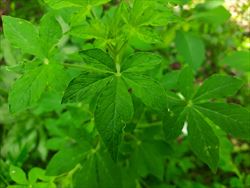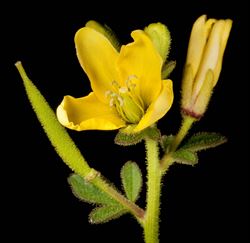- Widespread. In Australia, and most Pacific island countries.
- Annual, often perennial, fast-growing, found in many soil types - woodlands, open forests, monsoon forests, grasslands, fallow land, wasteland, along roadsides. Mostly, weed of rice and sugarcane. Invasiveness assisted by seeds without dormancy and rapid reproduction.
- Stems up to 1.5m, hairy, sticky, possibly woody at base. Leaves, 3-5 oval leaflets, with long stalks, hairy, round or pointed at ends. Three to six flowers on unbranched stalks, up to 40cm, each with four rectangular to oval yellow petals (8-16mm long), and leaf-like sepals behind. Flowers open in mornings only. Fruits, hairy, sticky, ridged, up to 10cm.
- Spread: seeds dispersed by wind and water, on machinery/vehicles, livestock, clothes. Sent internationally and used in traditional medicines.
- Biosecurity: risk from sticky fruits easily moved on animals/people/vehicles. Declared noxious weed in USA. Seed is available for purchase on the Internet.
- Biocontrol: none.
- Cultural control: hand-weed; mulch (5-10cm) to prevent seedling growth; clean soil and seeds from machinery/vehicles; check clothing; prevent access to livestock.
- Chemical control: CABI - monolinuron, trifluralin, metribuzin, diuron, oxadiazon, chlorbromuron, atrazine, prometryne, terbutryne. Only metribuzin registered in EU. In Australia, first five registered. Other suggestions - 2,4-D, dicamba, MCPA, (registered in Australia and EU). In Fiji, glyphosate.






